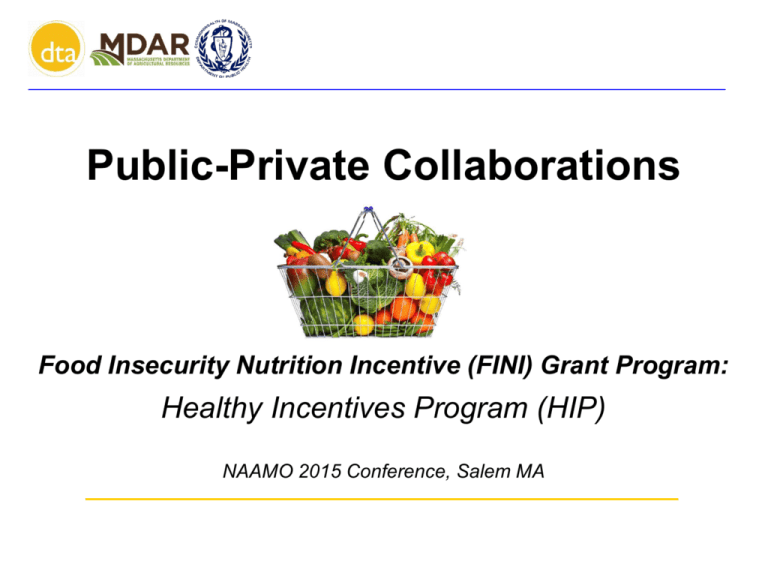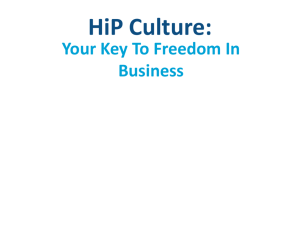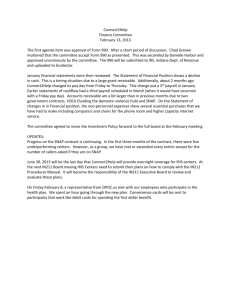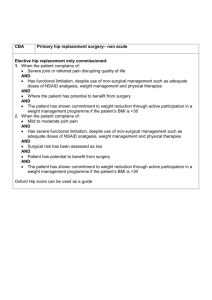MDAR Public-Private Collaborations
advertisement

Public-Private Collaborations Food Insecurity Nutrition Incentive (FINI) Grant Program: Healthy Incentives Program (HIP) NAAMO 2015 Conference, Salem MA Collaborative Efforts: Examples 1. Farmers’ Market Working Group 2. SNAP – EBT Equipment at Farmers’ Markets 3. Inter-Departmental Farmers’ Market Tours 4. Healthy Incentives Pilot (HIP) 5. SNAP CSA Recurring Payment Pilot 6. Food Insecurity Nutrition Incentive (FINI) Grant Program 2 What is FINI? Food Insecurity Nutrition Incentive Grant Program (FINI) USDA-NIFA: National grant program – $31.5 million in FY14/FY15 Supports projects to increase the purchase of fruits and vegetables among SNAP clients by providing incentives at the point of sale Three categories of projects requested: Tier 1: FINI Pilot Projects-FPP Tier 2: FINI Multi-year Community-based Projects-FP Tier 3: FINI Multi-year Large-Scale Projects-FLSP RFA based on best practice –Healthy Incentives Pilot (HIP) DTA was awarded a Tier 3 FINI grant on April 1, 2015 3 FINI Project: Healthy Incentives Program (HIP) Expansion of the Healthy Incentives Pilot = Healthy Incentives Program Massachusetts statewide coalition Builds upon established HIP infrastructure and lessons learned Provides an incentive benefit statewide at the following points of sale: Seasonal and winter Farmers’ Markets Farm Stands Mobile Markets Community Supported Agriculture (CSA) Programs Dollar for dollar match for F&V purchases, $40/$60/$80 cap per month Available to SNAP clients statewide Incentive instantly applied to SNAP customers’ EBT card Culturally appropriate foods 4 HIP Goals & Outcomes Project goals: Reduce barriers to SNAP client and retailer participation Increase availability of locally grown fruits and vegetables for SNAP clients Assess the impact of the new incentive program on participants’ purchase of fruits and vegetables to inform future expansion Intended project outcomes: Increased purchase of fruits and vegetables by SNAP clients Increased usage of SNAP benefits for purchasing locally grown fruits and vegetables at the four points of sale Established sustainable statewide matching/incentive program 5 HIP Points of Access Overview of the Four HIP Points of Access: 1. Seasonal & Winter Farmers’ Markets: Expands HIP implementation using one of the four modes of EBT processing. Includes Boston Bounty Bucks digitization, and the new Boston Public Market. 2. Farm Stands: Utilizes a wireless option, mobile platforms, or Xerox land-line terminals for processing. 3. Mobile Markets: Utilizes a wireless option or mobile platforms for processing. 4. CSA: Initiated via completion of CSA Membership Agreement, serves as client receipt, payments on client’s monthly benefit availability date. 6 HIP Coalition Massachusetts’ Interdepartmental partnership (DTA, DAR, DPH) with support of broad, diverse coalition of statewide community partners. Primary Regional Partners: Southeast, Eastern, Northeast, Central, Western Federation Mass Farmers Markets “Buy Locals” (9) Project Bread Food Banks (4) UMass Stockbridge School of Agriculture DTA-SNAP Nutrition Education (SNAP Ed) Providers WIC Program Community Coordinators & Local Offices Mass in Motion (27 Grantees—60 Communities) Local community partners, direct farms, farmers’ markets Mass Convergence Partnership and Associated Grant Makers 7 Regional Approach Mirrors current DTA SNAP Nutrition Education Geographic Service Area (GSA) based on 22 DTA service areas: Southeast Region: Brockton, Fall River, Hyannis, New Bedford, Plymouth, Taunton Eastern Region: Dudley, Newmarket Northeast Region: Chelsea, Lawrence, Lowell, Malden, North Shore Central Region: Fitchburg, Framingham, Southbridge, Worcester Western Region: Greenfield, Holyoke, Pittsfield, Springfield State, Springfield Liberty Takes into account cultural and operational differences. Utilizes existing network of community partners. 8 HIP Coalition Networks & Linkages 1. Outreach 2. Marketing 3. Education SNAP Clients & Retailers Local Community Partners 4. Training 5. Support DTA TAOs & Advisory Boards + WIC Offices & MiM Communities Regional Partners – HIP Advisory Committees DTA/MDAR/DPH Evaluation & Reporting Rigorous self-evaluation (process and outcome) – State contractor Comprehensive program evaluation - Independent federal contractor Required to participate Contribute to minimum data set Collaborate with independent evaluator to identify comparison sites State reporting requirements, for subawardees and subgrantees 10 HIP Timeframe April, 2015: Award announced July 2015 – September 2016: Planning, development and systems testing phase April 2017 – March 2020: Operation phase of project (3 years) April 2020 – June 2020: HIP operations close out & final reporting 11 What was HIP? (reference slide) Healthy Incentives Pilot (HIP) Authorized in 2008 US Farm Bill Rigorously evaluated demonstration grant Only one of its kind in the country Tested the effects of providing a financial incentive Pilot site in Hampden County, Massachusetts HIP was implemented from November 1, 2011 through December 31, 2012 12 For More Information Frank Martinez Nocito Assistant Director, SNAP Nutrition Education Department of Transitional Assistance frank.martineznocito@state.ma.us (413) 858-1380 www.mass.gov/dta/hip HIP reports available at: http://www.fns.usda.gov/snap/hip/ 13







